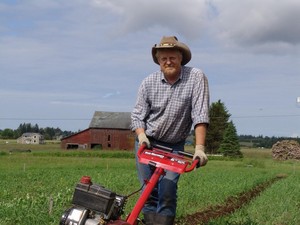19 Mar Thu 2009
The Calorie Cost of Using Tillers
We don't use tractors for tilling, planting or cultivation. If I need some field mowing done, I hire the neighbor and I spend about $100 per year. My gas costs last year for my tillers was less than $100 and my estimate of actual gallons used was 27.5 gallons. A gallon of gas contains approximately 31,000 calories. [By the way, these are kilocalories, but calories is the usual shorthand used. Some scientists prefer joules, but since calories are understood by nearly everyone as a valid unit of energy produced and consumed, I still use calories. This is science adapting to cultural usage.] Therefore, my tiller gas last year amounted to 852,500 calories (31,000 X 27.5). As a contrast, I estimate I put in 1000 calories per day into the farm out of a total calorie usage of 2500 per day. In other words, I put in 365,000 calories to grow food in 2008. These are gross estimates of course, but I only have this one job and it is my main focus. I do participate in other activities and I do drop 10-15 pounds in the summer each year, so after subtracting 1250 calories for the daily maintenace of my body from my calorie count per day and 250 calories for non-work activities, I feel 1000 calories per day for farm work is a good conservative number. It might be less but probably not more.
I cultivated 2.5 acres last year by hand and with my tillers, so if I contributed 365,000 calories and the tiller gas I used contributed 852,500 calories, the total of just these two energy sources was 1,217,500 calories, or 487,000 calories per acre. Now, based on last year's potato production of 1,998.6# for 1785 row feet, or 4,462.5 sq. ft. (rows are on 2.5 foot centers), I produced the equivalent of .448# of potatoes per square foot, or 19,500# of potatoes per acre. Potatoes are about 350 calories per pound (some say 385 but I will use the lower figure), so that is 6,825,000 calories per acre. If I had produced potatoes, at this rate, on 2.5 acres, I would have had over 17 million calories produced, for a calorie cost of 1.2 million calories. In realistic terms, potatoes form the upper limit on calories produced per acre as they easily produce twice as many calories per wheat per acre. [The usual metric is 6-8 million calories per acre for potatoes and 3-4 million calories per acre for wheat. Diversified vegetable production is always going to be lower than just potatoes, hence potato production as defining the upper limit.]
Here's the bottom line. Potatoes produced at a rate (remember this is a relative rate, not an absolute quantity) of 17 million calories and human+gas inputs at 1.2 million calories equals a 14-to-1 ratio. This is a very nice metric and reinforces my claim that I produce over 10 calories of food for every calorie I put into producing the food. What is new about this analysis is the role of tiller gas. It would be an affront to mathematics to try and isolate the role of the tiller gas vs. human labor, because there is also an interaction between the two variables. In other words, I get a lot of work done because I use a combination of tiller gas and human sweat to drive both engines (the tiller and my body), which are combined into a practical meta-engine of the human behind the tiller. However, I can say this: The most practical alternative right now, at this time in history, is a human using a walk-behind tiller. The gas costs in dollars and calories are low and the human sweat provides an added dimension to the calories produced by the fossil fuels. In the brave new world after petroleum is no longer feasible, it is likely farmers will actually make a fair return on their labor, so I might be able to make a living on only half an acre that I till, plant and cultivate entirely by hand.


Hi, Walt -
I just ran across your blog and find it interesting. I think you were quite on the mark about CSA marketing. Too many new (organic) farming types talk in romantic terms, though some here in central Wisconsin talk more in stark economic terms: they love farming, but one says that he's just barely earning a minimum wage.
The local farmshed group is trying to build up local farming and local food. But it's a hard road task to build up the market demand and the needed infrastructure.
I've started gardening (following retirement from University teaching) and am expanding my gardens to 2500 sq. ft. this summer. I also lie to read about farming and gardening. Albert Howard's The Soil and Health emphasized the critical importance of building up a biologically healthy soil. I take that message to heart.